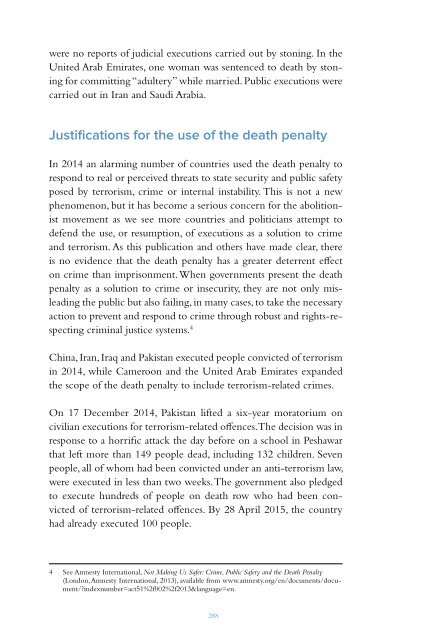PENALTY
DBk0302s7Xm
DBk0302s7Xm
Create successful ePaper yourself
Turn your PDF publications into a flip-book with our unique Google optimized e-Paper software.
were no reports of judicial executions carried out by stoning. In the<br />
United Arab Emirates, one woman was sentenced to death by stoning<br />
for committing “adultery” while married. Public executions were<br />
carried out in Iran and Saudi Arabia.<br />
Justifications for the use of the death penalty<br />
In 2014 an alarming number of countries used the death penalty to<br />
respond to real or perceived threats to state security and public safety<br />
posed by terrorism, crime or internal instability. This is not a new<br />
phenomenon, but it has become a serious concern for the abolitionist<br />
movement as we see more countries and politicians attempt to<br />
defend the use, or resumption, of executions as a solution to crime<br />
and terrorism. As this publication and others have made clear, there<br />
is no evidence that the death penalty has a greater deterrent effect<br />
on crime than imprisonment. When governments present the death<br />
penalty as a solution to crime or insecurity, they are not only misleading<br />
the public but also failing, in many cases, to take the necessary<br />
action to prevent and respond to crime through robust and rights-respecting<br />
criminal justice systems. 4<br />
China, Iran, Iraq and Pakistan executed people convicted of terrorism<br />
in 2014, while Cameroon and the United Arab Emirates expanded<br />
the scope of the death penalty to include terrorism-related crimes.<br />
On 17 December 2014, Pakistan lifted a six-year moratorium on<br />
civilian executions for terrorism-related offences. The decision was in<br />
response to a horrific attack the day before on a school in Peshawar<br />
that left more than 149 people dead, including 132 children. Seven<br />
people, all of whom had been convicted under an anti-terrorism law,<br />
were executed in less than two weeks. The government also pledged<br />
to execute hundreds of people on death row who had been convicted<br />
of terrorism-related offences. By 28 April 2015, the country<br />
had already executed 100 people.<br />
Also in December 2014, Indonesia announced its intention to resume<br />
executions for drug-related offences to confront what it called a<br />
national emergency. On 19 January 2015, six people were executed<br />
and the Indonesian authorities announced plans to put more people<br />
to death throughout the year. On 28 April, eight people, including<br />
Indonesian and foreign nationals, were executed by firing squad. All<br />
of them had been convicted of drug trafficking. The executions went<br />
ahead despite international calls for clemency.<br />
China made use of the death penalty as a tool in the Strike Hard<br />
campaign against terrorism and violent crime in the Xinjiang Uighur<br />
Autonomous Region. Three people were sentenced to death in a<br />
mass sentencing event that was held in an outdoor sports arena in<br />
May 2014. Those sentenced had been convicted of terrorism, separatism<br />
and murder. Between June and August, 21 people were executed<br />
in the Xinjiang Uighur Autonomous Region in relation to various<br />
terrorist attacks.<br />
Jordan resumed executions at the end of 2014 after an eight-year<br />
hiatus, executing 11 men for murder. The executions followed the<br />
establishment, weeks before, of a special committee of the Cabinet<br />
to look into lifting the suspension on executions as a deterrent to<br />
murder and in response to public demand.<br />
The ongoing use of the death penalty in<br />
contravention of international law<br />
In 2014, as in the past, many of the states that retain the death penalty<br />
continued to use it in contravention of international law and standards.<br />
Unfair trials, “confessions” extracted through torture or other<br />
ill-treatment, and the use of the death penalty against juvenile offenders<br />
and people with mental or intellectual disabilities and for crimes<br />
other than intentional killing continued to be concerning features of<br />
the use of the death penalty.<br />
4 See Amnesty International, Not Making Us Safer: Crime, Public Safety and the Death Penalty<br />
(London, Amnesty International, 2013), available from www.amnesty.org/en/documents/document/?indexnumber=act51%2f002%2f2013&language=en.<br />
People with mental or intellectual disabilities were under sentence of<br />
death in several countries including Indonesia, Japan, Malaysia, Pakistan,<br />
Trinidad and Tobago and the United States.<br />
288 289


